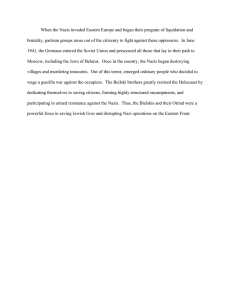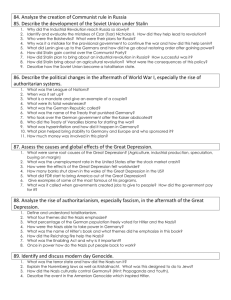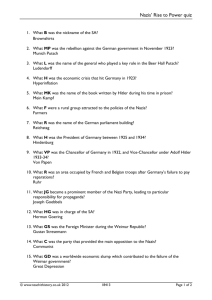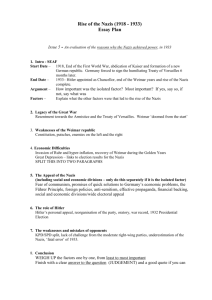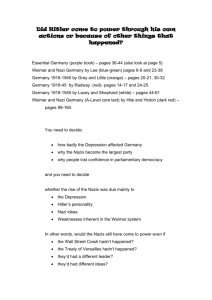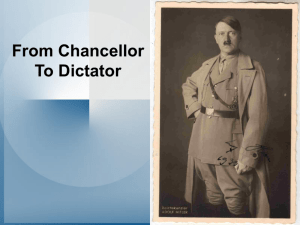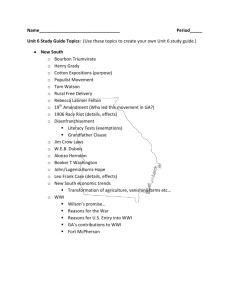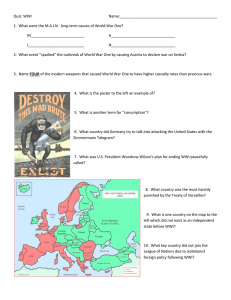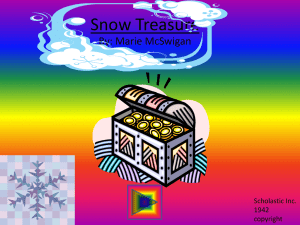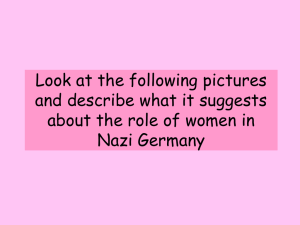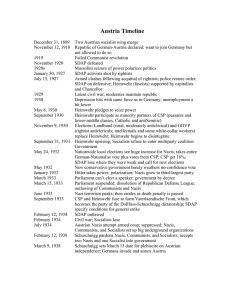Chapter 17: The West Between the Wars 1919 – 1939
advertisement
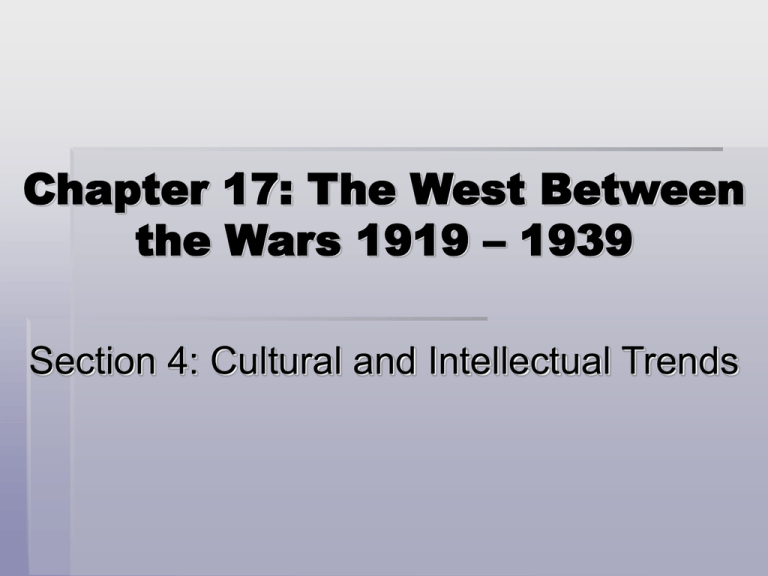
Chapter 17: The West Between the Wars 1919 – 1939 Section 4: Cultural and Intellectual Trends L. Mass Culture: Radio and Movies ▪ In the late 19th century, inventions such as motion pictures and discoveries such as wireless radio waves changed mass communication. ▪ 1920s, radio broadcasting facilities were built in the U.S., Europe, and Japan and the mass production of radios began ▪ First full-length motion pictures came out prior to WWI but became an important part of mass entertainment over the next two decades Charlie Chaplin ▪ Radio and Movies were used for political purposes; Nazis broadcast Hitler’s speeches over the air; the impact was great therefore the Nazis urged manufacturers to produce cheap radios and allow people to buy them on installment plans; in U.S. Roosevelt broadcast the “Fireside Chats” Adolf Hitler listens to a radio broadcast of the results of German parliamentary elections. (March 5, 1933) Franklin D. Roosevelt begins famous "fireside chat" radio broadcasts to the nation from the White House. ▪ Nazis used movies to spread propaganda; propaganda minister, Joseph Goebbels used them to influence the masses; ▪ Most famous Nazi films was directed by Leni Riefenstahl called The Triumph of the Will – it showed the 1934 Nazi Party rally at Nuremburg and conveyed the power of the Nazis Joseph Goebbels Leni Riefenstahl M. Mass Leisure: ▪ After WWI, the 8 hour work day became common for many Europeans, and people had more free time. ▪ Leisure activities, such as attending professional sports events and traveling became popular; people used trains, buses, and cars to reach their destinations An old poster for travelling by train to South Shields during the 1920s ▪ Totalitarian states used mass leisure to help control the people; the Nazis had a program called “Strength through Joy” which offered cultural activities, sporting events, and inexpensive vacations; this program was intended to fill free time and keep the working people happy Advertising poster for (Kraft durch Freude), Strength Through Joy Trips (after 1933). The 10,000-room holiday resort designed to strengthen Nazi families as part of the Nazis' sinister scheme of social engineering N. Artistic and Literary Trends: Many Europeans experienced profound despair following WWI. The horror of the war left them convinced that there was something profoundly wrong with humans and Western values. The Great Depression and the rise of Fascism increased this feeling. - Art: Nightmares and New Visions: ▪ Political and social despair after WWI led to intellectual uncertainties. Many people felt the world made no sense, so why should art? ▪ Dada was a style of art that expressed the insanity of life. The Dadaists art expressed the insanity of life. One technique they used was photomontage – making a picture by combining photographs Hannah Höch, Cut with the Dada Kitchen Knife through the Last Weimar Beer-Belly Cultural Epoch in Germany, 1919, collage of pasted papers Raoul Hausmann, ABCD, 1923-1924 Dada Art - Hannah Hoch A lot of her art comments on new roles for women in this new mass culture. ▪ Surrealism expressed a reality beyond the material world. Surrealist artists often depicted scenes from the unconscious. Salvador Dali famous surrealist artist. Salvador Dali: Three Sphinxes Of Bikini The painting consisted of one head, one tree and one nuclear mushroom. The head might represents humanity, while the tree represents nature and mushroom cloud represents destruction. When nuclear exploded, the tree was the one closest to it then come to the head, which could mean that impact on nature is far greater than impact on human. Salvador Dali: Galatea of the Spheres He uses a repetition of spheres to create the image of the woman he loves, Gala. Salvador Dali: The Persistence of Memory ▪ Many people disliked modern art, German Nazis in particular. Hitler condemned it as degenerate therefore the Nazis proposed a German art that would glorify the strength and heroism of the Aryan race. - Literature: The Search for the Unconscious: ▪ The Irish writer James Joyce wrote Ulysses, 1922 and others in the stream of consciousness technique to record the innermost thoughts of their characters. ▪ Herman Hesse wrote Siddharta and Steppenwolf. He was influenced by Freud’s psychology and Buddhism, and focused on the psychological confusion of modern life. James Joyce Herman Hesse O.The Heroic Age of Physics: ▪ During the years following WWI, the long-held Newtonian views of physics became undermined. New theories based on Einstein showed that all phenomena could not be completely defined and predicted. ▪ 1927, German physicist Werner Heisenberg explained what he called the uncertainty principle. According to Heisenberg, the behavior of subatomic particles was not predictable. This suggest that all physical laws are based on uncertainty, or randomness; his ideas constituted a new world view Werner Heisenberg
